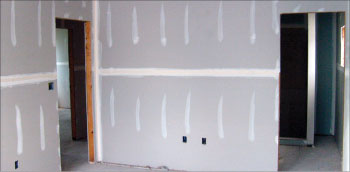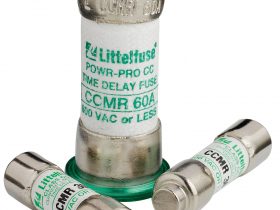While performing inspections, you may be confronted with electrical components that just don’t appear normal and it may be for unexpected reasons. It is important to understand that there is an issue impacting indoor air quality currently being investigated and it may impact electrical metal components. Although extreme, and not quite the norm, some individuals are experiencing that Chinese drywall, sometimes referred to as “contaminated drywall” or “tainted drywall,” has negative impacts on health and on metal products in a home. This issue is being studied by a few organizations including the U. S. Consumer Product Safety Commission (CPSC), the U.S. Environmental Protection Agency (EPA), the Centers for Disease Control and Prevention (CDC), the Agency for Toxic Substances and Disease Registry (ATSDR), and the U. S. Department of Housing and Urban Development (HUD). This column is provided to give you some insight to an issue that can negatively impact the health of those living in the home as well as impacting metal items in the home.

Photo 1
The Problem

The first incident report was received by the CPSC in December of 2008. Homeowners have reported that the drywall in their homes has caused bad odors, corrosion, and sickness. In some cases the problems have driven the occupants from their homes. The complaints include:
- Headaches
- Itchy eyes
- Scratchy, burning throats
- Nose bleeds
- Sinus infections
- Breathing problems
- Skin irritations
In addition to these issues, there are also reports of corrosion of metals, including wiring, due to the toxins from the drywall. If your gut reaction is to presume that only those products touching the drywall have a potential to be impacted and to exhibit corrosion, you are most certainly incorrect. Any product in the home, touching the drywall or not, can exhibit corrosion problems simply due to the toxins in the air. Complaints of corrosion have been received by the CPSC for the following:
- Air conditioning evaporator coils. In this case, corrosion leads to pitting of the tube and leaking of Freon. Your Green radar/alarm should have just alarmed.
- Smoke alarms sounding in the middle of the night without any apparent cause.
- New appliances including televisions, microwave ovens, refrigerators, dishwashers and computers suddenly stop working for no apparent reason.
The CPSC has completed various reports that contain information on the impact to electrical components. They are finding that the harvested components from affected homes are exhibiting significant corrosion of copper wiring and a lesser degree of corrosion to other parts of the electrical equipment such as the screws and metal and conductors contained within. No indications of significant overheating of conductors or other conductive parts have been recorded. No fires have been attributed to this problem as well. This report and more can be found at the CPSC web site (http://www.cpsc.gov/info/drywall).

What Can You Do?
1. Consider the age of the home or work completed in the home. Was the home constructed or was drywall added since 2001?
2. Look for corrosion of metal components in the home. Look for black corrosion on any copper tubing, including that which you find on the conditioner coils in refrigerators. Look at air conditioning units as well. If the air conditioner cannot cool the home, this may be an indicator that a leak may have occurred and the refrigerant is escaping into the atmosphere. Coil failures with this problem typically occur every 6–14 months
3. Look for more metal corrosion. Any blackening of copper wires, ground wires, uncoated copper pipes and fittings, chrome-plated bathroom fixtures, silver or copper jewelry and even the back of the mirrors which have a foil. (Caution should be used when looking at electrical wires. Educate homeowners not to touch any copper wires or try to remove any receptacle plates or loadcenter covers. Safety first.)
These are things homeowners can do on their own. It is very important to educate them on electrical safety and not have them remove covers to any electrical equipment. Note that an egg-like smell or a sweet smell in the home is not on the list above. These are not reliable indicators as a home may have the problem but not have an odor.
If homeowners can attest to items above having an issue, you can go a little further to help identify whether they have a problem by looking for markings on the back of the drywall. Find locations where the back is exposed and look for the word “China” in big letters somewhere, indicating that its origin is China. Other than doing this, you are into testing the air or the gypsum for certain chemical components. There is handheld equipment on the market that can detect Strontium levels. If these levels exceed 2,000 mg/kg (ppm), the gypsum used in the drywall may have been mined in China.
If you suspect a home has a problem with its drywall, a report can be filed with the CPSC through their web site: http://www.cpsc.gov/info/drywall. Use this link as well to learn more about the issue as further studies are conducted and alerts arise. It is important to connect homeowners with this resource.
For More Information
Remember, this problem is still unfolding and more reports and study results will be available. The CPSC has spent more than $3.5 million on this investigation constituting more than 3.5% of their annual budget. The CPSC has established a web site specifically focusing on this issue and can be found at the following URL: www.cpsc.gov/info/drywall. Also, the CDC has established a site and can be found at the following URL: www.cdc.gov/nceh/drywall. Arm yourself with as much knowledge on the topic as possible.
As always, keep safety at the top of your list and ensure that you and those around you live to see another day. If you have any tips or ideas you would like to share, please feel free to send them to me at thomasadomitrovich@eaton.com. I look forward to your input to these articles and guidance for future articles of Safety in Our States.














Find Us on Socials